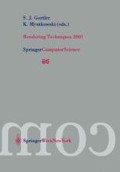Abstract
We present a framework for accelerating interactive rendering, grounded in psychophysical models of visual perception. This framework is applicable to multiresolution rendering techniques that use a hierarchy of local simplification operations. Our method drives those local operations directly by perceptual metrics; the effect of each simplification on the final image is considered in terms of the contrast the operation will induce in the image and the spatial frequency of the resulting change. A simple and conservative perceptual model determines under what conditions the simplification operation will be perceptible, enabling imperceptible simplification in which operations are performed only when judged imperceptible. Alternatively, simplifications may be ordered according to their perceptibility, providing a principled approach to best-effort rendering. We demonstrate this framework applied to view-dependent polygonal simplification. Our approach addresses many interesting topics in the acceleration of interactive rendering, including imperceptible simplification, silhouette preservation, and gaze-directed rendering.
Access this chapter
Tax calculation will be finalised at checkout
Purchases are for personal use only
Preview
Unable to display preview. Download preview PDF.
References
Barten, Peter. “The Square-Root Integral”, In Human Vision, Visual Processing, and Digital Display, vol. 1077, Proceedings SPIE (1989)
Bolin, Mark. and G. Meyer. “A Perceptually Based Adaptive Sampling Algorithm”, Computer Graphics, Vol. 32 (SIGGRAPH 98).
Campbell, F., Gubisch, R. “Optical Quality ofthe Human Eye”, Journal of Physiology 186.
Campbell, F.W. and Robson, J.G. “An Application of Fourier Analysis to the Visibility of Contrast Gratings”, Journal of Physiology, 187 (1968)
Clark, James H. “Hierarchical Geometric Models for Visible Surface Algorithms,” Communications of the ACM, Vol. 19, No 10, pp 547–554.
Cohen, J, M. Olano, and D. Manocha. “Appearance-Preserving Simplification,” Computer Graphics, Vol. 32 (SIGGRAPH 98).
Daly, S. “Visible differences predictor: An algorithm for the assessment of image fidelity,” Digital Images and Human Vision (A. Watson, ed.), pp 179–206, MIT Press (1993).
Ferdwada, James, S. Pattanaik, P. Shirley, and D. Greenberg. “A Model of Visual Masking for Realistic Image Synthesis”, Computer Graphics, Vol. 30 (SIGGRAPH 96).
Funkhouser, Tom, and C. Sequin. “Adaptive display algorithm for interactive frame rates during visualization of complex virtual environments”, Computer Graphics, Vol. 27.
Heckbert, Paul, and M. Garland. “Survey of Polygonal Surface Simplification Algorithms”, SIGGRAPH 97 course notes (1997).
Hoppe, Hughes. “View-Dependent Refinement of Progressive Meshes”, Computer Graphics, Vol. 31 (SIGGRAPH 97).
Johnson, David, and E. Cohen. “Spatialized Normal Cone Hierarchies”, Proceedings ACM Symposium on Interactive 3D Graphics (2001).
Kelly, D.H. “Spatial Frequency Selectivity in the Retina”, Vision Research, 15 (1975).
Lindstrom, Peter. and Turk, G. “Image-Based Simplification”, ACM Transactions on Graphics, July 2000 (2000).
Lubin, Jeffery. “A Visual Discrimination Model for Imaging System Design and Evaluation”, Vision Modelsfor Target Detection and Recognition, World Scientific (1995).
Luebke, David, and C. Erikson. “View-Dependent Simplification of Arbitrary Polygonal Environments”, Computer Graphics, Vol. 31 (SIGGRAPH 97).
Luebke, David. “A Developer’s Survey of Polygonal Simplification Algorithms”, IEEE Computer Graphics & Applications (May 2001). See tech report CS-99-07, U of Virginia.
Luebke, David, and B. Hallen. “Perceptually-Driven Interactive Rendering”. Technical report CS-2OO1-01, University of Virginia (2000).
Luebke, David. See http://vdslib.virginia.edu.
J. L. Mannos, D. J. Sakrison, “The Effects of a Visual Fidelity Criterion on the Encoding of Images”, IEEE Transactions on Information Theory, pp. 525–535, Vol. 20, No 4, (1974).
Oshima, Toshikazu, H. Yamammoto, and H. Tamura. “Gaze-Directed Adaptive Rendering for Interacting with Virtual Space”, Proceedings of VRAIS 96 (1996).
Puppo, Enrico, and R. Scopigno. “Simplification, LOD and Mu1tiresolution—Principles and Applications”, Eurographics’ 97 Tutorial Notes, PS97 TN4 (1997).
Ramasubramanian, Mahesh, S. Pattanaik, and D. Greenberg. “A Perceptually Based Physical Error Metric for Realistic Image Synthesis”, Computer Graphics, Vol. 33.
Reddy, Martin. “Perceptually-Modulated Level of Detail for Virtual Environments”, Ph.D. thesis, University of Edinburgh, 1997.
Rovamo, J. and Virsu, V. “An Estimation and Application of the Human Cortical Magnification Factor”, Experimental Brain Research, 37 (1979)
Rushmeier, H., G. Ward, C. Piatko, P. Sanders, and B. Rust. “Comparing Real and Synthetic Images: Some Ideas About Metrics,” In Rendering Techniques’ 95, pp 82–91, Springer-Verlag (1995).
Rusinkiewicz, S. and Levoy, M. “QSplat: A Multiresolution Point Rendering System for Large Meshes”, Computer Graphics, Vol. 34 (SIGGRAPH 2000).
Scoggins, Randy, R. Machiraju, and R. Moorhead. “Enabling Level-of-Detail Matching for Exterior Scene Synthesis”, Proceedings of IEEE Visualization 2000 (2000).
Walter, Bruce, P. M. Hubbard, P. Shirley, and D. Greenberg. “Global Illumination using Local Linear Density Estimation”, ACM Transaction on Graphics (1997).
Xia, Julie and Amitabh Varshney. “Dynamic View-Dependent Simplification for Polygonal Models”, Visualization 96.
Zhang, Hansong, and K. Hoff. “Fast Backface Culling Using Normal Masks”, Proceedings of ACM Symposium on Interactive 3D Graphics (1997).
Author information
Authors and Affiliations
Editor information
Editors and Affiliations
Rights and permissions
Copyright information
© 2001 Springer-Verlag Wien
About this paper
Cite this paper
Luebke, D., Hallen, B. (2001). Perceptually Driven Simplification for Interactive Rendering. In: Gortler, S.J., Myszkowski, K. (eds) Rendering Techniques 2001. EGSR 2001. Eurographics. Springer, Vienna. https://doi.org/10.1007/978-3-7091-6242-2_21
Download citation
DOI: https://doi.org/10.1007/978-3-7091-6242-2_21
Published:
Publisher Name: Springer, Vienna
Print ISBN: 978-3-211-83709-2
Online ISBN: 978-3-7091-6242-2
eBook Packages: Springer Book Archive

